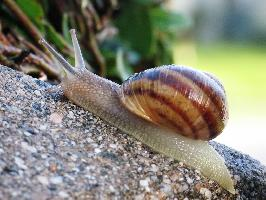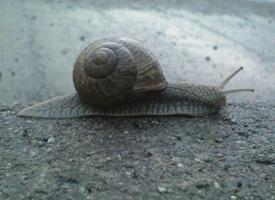
Váhy a míry
| Výška v kohoutku | od 25 do 35 mm |
|---|
Popis zvířete
The garden snail, scientifically known as Cornu aspersum (formerly Helix aspersa), is a terrestrial gastropod mollusk that belongs to the family Helicidae. This species, native to the Mediterranean region, has been inadvertently introduced to many parts of the world, often becoming a ubiquitous presence in gardens, agricultural areas, and natural habitats outside its native range.Characterized by its coiled shell, the garden snail's shell is roughly spherical in shape and can vary in color from light brown to a darker, almost black hue, often featuring a pattern of stripes or splotches that can be quite variable from one individual to another. The size of the shell can reach up to about 40 mm in diameter and 30 mm in height, although this can vary depending on environmental conditions and the snail's diet.
The body of the garden snail is soft and slimy, capable of extending well beyond the confines of its shell when active. Its coloration can range from a light grey to a darker brown. The snail has two pairs of tentacles on its head; the longer pair houses the eyes at their tips, while the shorter pair is used for tactile and olfactory purposes. The garden snail is a hermaphrodite, meaning each individual possesses both male and female reproductive organs, allowing for a flexible approach to reproduction.
Garden snails are known for their slow movement, facilitated by the secretion of mucus, which serves both to reduce friction against the surface and to prevent dehydration. This mucus trail is often visible as a shiny path, marking the snail's journey.
In terms of diet, the garden snail is primarily herbivorous, feeding on a wide variety of plants. While they can sometimes be found consuming healthy plant material, they often prefer decomposing organic matter, making them participants in the nutrient cycle of their ecosystems. However, their appetite for plants can also lead them to be considered pests in gardens and agricultural settings, where they can cause significant damage to crops and ornamental plants.
Reproduction in garden snails is a fascinating process, as they are capable of mating with any mature individual due to their hermaphroditic nature. The mating process involves a complex courtship ritual that can last several hours, culminating in the exchange of sperm. Subsequently, both participants can lay eggs, which are deposited in moist soil or under debris for protection. The eggs hatch into tiny snails, which will take about two years to reach full maturity.
Despite their sometimes-pest status, garden snails have also been embraced by some cultures as a delicacy, known as escargot, and are farmed for this purpose in various parts of the world. Additionally, their mucus has been researched for cosmetic and medicinal applications, believed to have properties beneficial for skin care.
In conclusion, the garden snail (Cornu aspersum) is a complex and adaptable creature, playing significant roles in the ecosystems it inhabits, from decomposer to a source of irritation for gardeners, and even as a culinary delight for some. Its presence in diverse environments worldwide is a testament to its adaptability and the interconnectedness of our global ecosystem.
Podobná zvířata
Nové fotografie zvířat
Top 10 zvířat
- Chinese water dragon (Physignathus cocincinus)
- Galápagos tortoise (Geochelone nigra complex)
- Dolphin gull (Leucophaeus scoresbii)
- Japanese macaque (Macaca fuscata)
- Colombian red howler (Alouatta seniculus)
- Sea urchins (Echinoidea)
- Moustached guenon (Cercopithecus cephus)
- Diana monkey (Cercopithecus diana)
- Common reed warbler (Acrocephalus scirpaceus)
- Common house mosquito (Culex pipiens)
